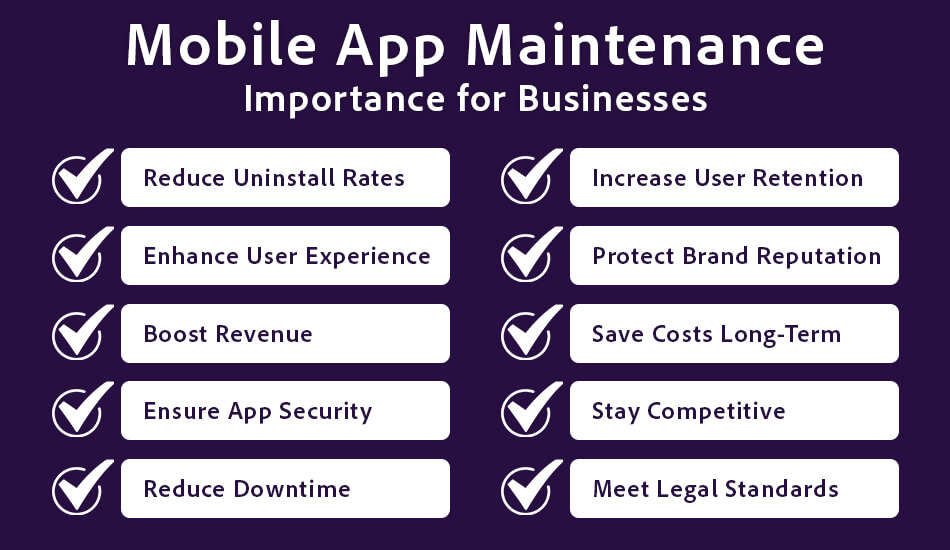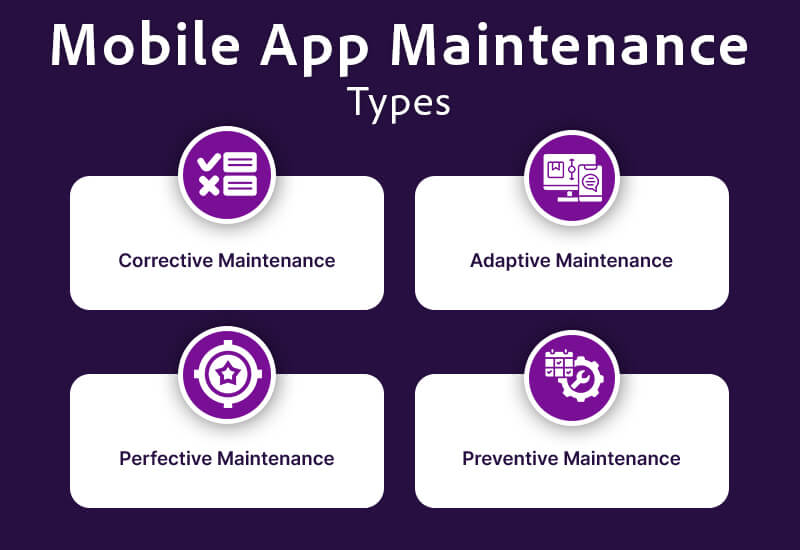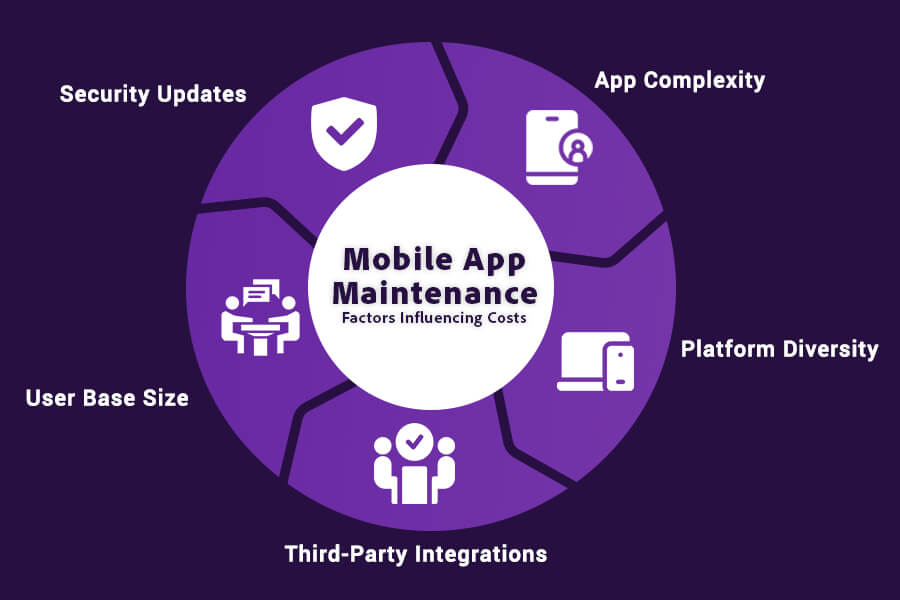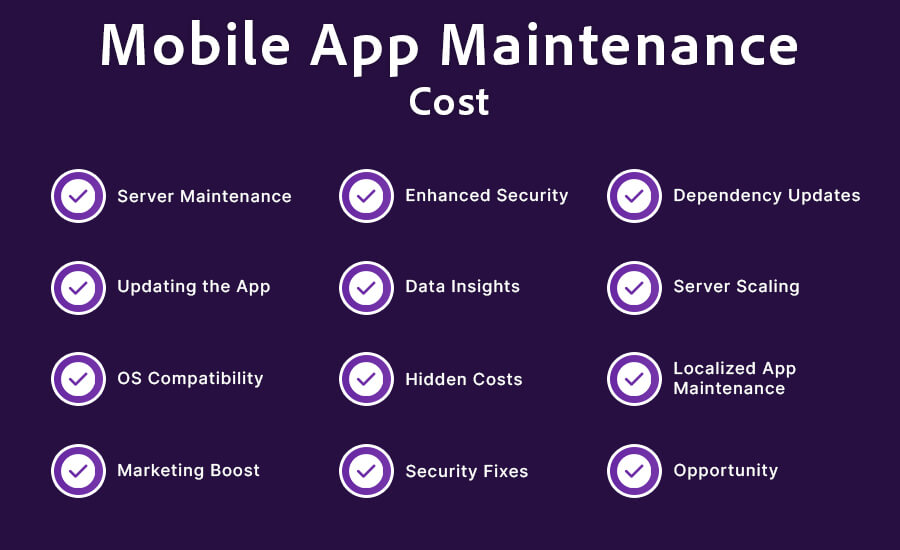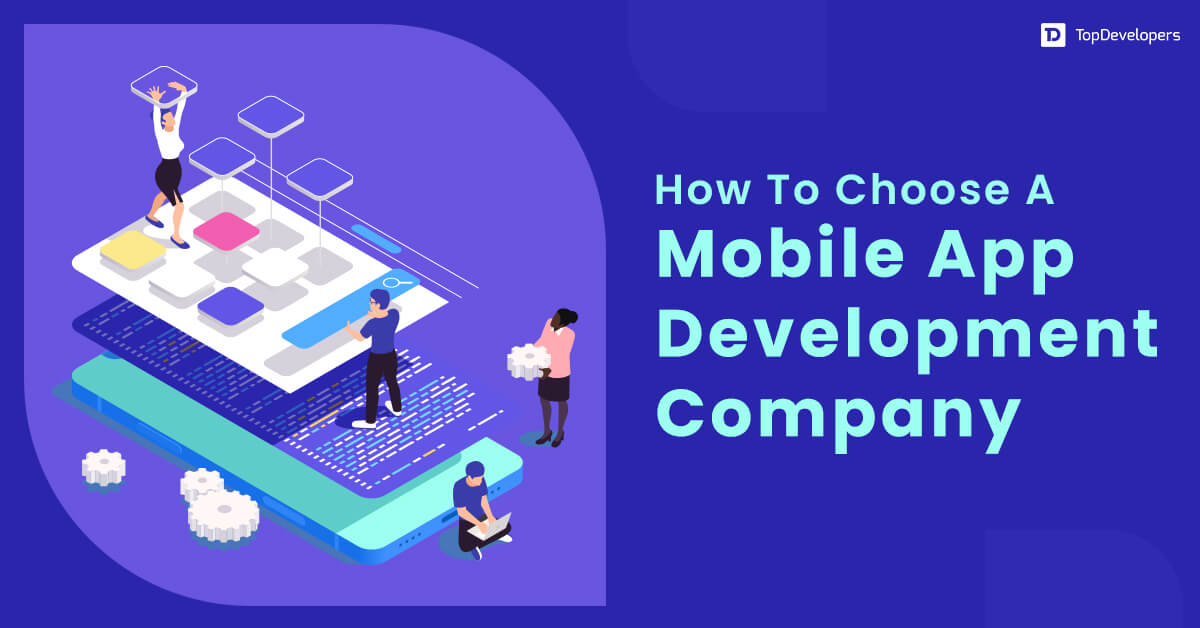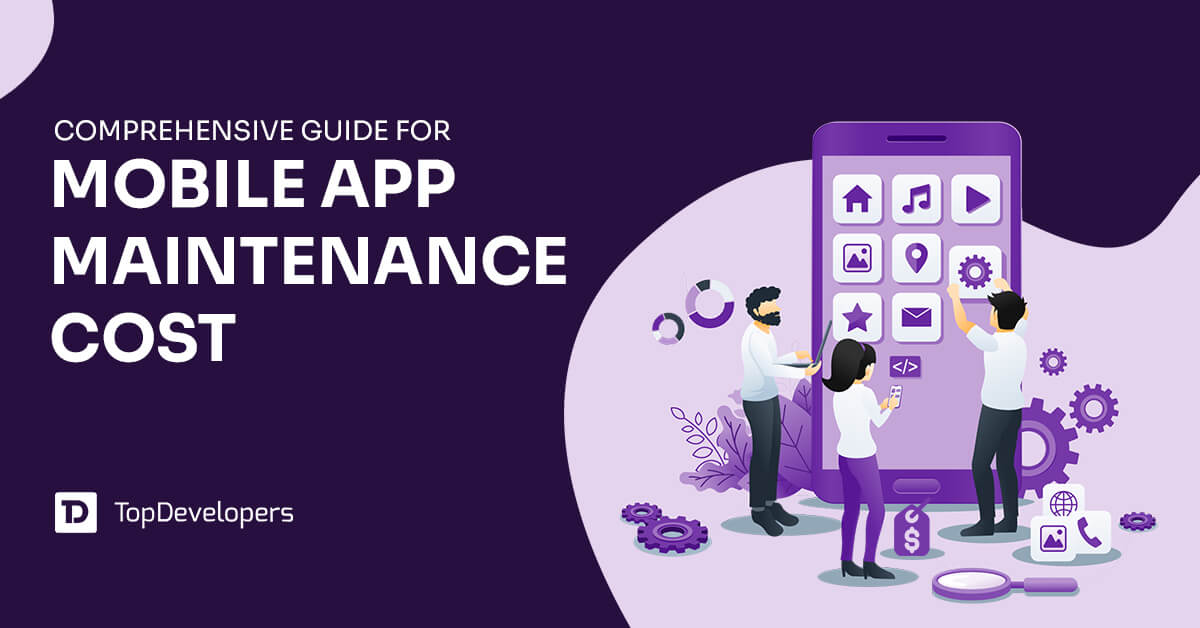
You know it very well—car maintenance extends the vehicle’s life. Preventive maintenance improves the car mileage, enhances safety on the road, minimizes repair costs, and minimizes the chances of a car breakdown.
The same goes for mobile apps after they are developed and launched. The company cannot rest on its laurels after the app is built. Instead, the real work starts right from this moment. This is termed mobile app maintenance. Regular maintenance not only complements the initial mobile app development cost but also ensures long-term user satisfaction and compliance with evolving market standards.
According to recent research, mobile app maintenance accounts for 15-20% of the total development cost annually. For instance, if an app costs $100,000 to develop, businesses might spend between $15,000 and $20,000 each year on maintenance.
According to the AppsFlyer report, 49% of apps are uninstalled within 30 days of installation, underscoring the importance of regular mobile app maintenance. Users frequently uninstall apps due to unmet expectations, with 50% citing poor performance, 37% pointing to crashes or bugs, and 24% concerned about outdated features or security issues, all of which can be addressed through consistent maintenance. Neglecting these crucial aspects leads to elevated uninstall rates, severely impacting user retention and overall app performance.
Mobile app maintenance not only ensures the app remains functional but also plays a critical role in retaining users, keeping the app competitive in the market, and complying with the latest security regulations.
Table of Contents
- What is Mobile App Maintenance?
- Why Is Mobile App Maintenance Important for Businesses?
- Types of Mobile App Maintenance
- Factors Influencing Mobile App Maintenance Costs
- What’s the Cost of Maintaining a Mobile App?
- Best Practices for Effective App Maintenance
- Maintaining Apps for Long-Term Success!
- FAQs regarding Mobile app maintenance cost
What is Mobile App Maintenance?
Mobile app maintenance is the process of continuously maintaining your application by monitoring, updating, and improving a mobile app after it has been launched. It ensures that your initial mobile app development cost continues to provide value by keeping the app functional, relevant, and secure. Just like maintaining a car ensures its long-term performance and safety, maintaining a mobile app keeps it functional, relevant, and secure.
This ongoing process involves multiple activities, including fixing bugs, updating features, enhancing compatibility with new operating systems, and ensuring the app aligns with user expectations. For instance, when Apple or Google releases a new OS version, apps must adapt to stay functional and provide a smooth user experience. Mobile app maintenance complements the mobile app development cost by ensuring that the initial investment delivers long-term value through consistent updates and improvements.
Why Is Mobile App Maintenance Important for Businesses?
Mobile apps are not a one-time investment; they require consistent care to remain functional, engaging, and secure. In the competitive app market, regular maintenance ensures your app delivers value to users while staying aligned with evolving technological and user demands. Without it, apps risk losing relevance, users, and revenue.
Diminish Uninstallation
Launching an app is just the beginning. To keep users loyal, regular updates and performance enhancements are crucial. Mobile app maintenance allows businesses to meet user expectations by offering fresh features, resolving bugs, and improving performance.
For instance, apps like WhatsApp and Instagram maintain their leading positions through consistent updates. Without proactive updates, businesses risk losing users to competitors or facing penalties for non-compliance with app store guidelines.
Deliver the Best Experiences
A seamless user experience (UX) is the foundation of an app’s success. Users today demand minimalistic design, intuitive app navigation, and glitch-free performance. Any failure in these areas can lead users to explore alternative apps.
Mobile app maintenance ensures your app stays aligned with user preferences and keeps up with evolving app UI/UX design trends by improving usability and addressing issues promptly. A great UX fosters positive reviews, boosts loyalty, and strengthens relationships with users, ultimately driving ROI.
Improve the Bottom Line
A well-maintained app directly impacts business growth by increasing user satisfaction and retention. Mobile app maintenance minimizes unexpected repair costs while improving user acquisition and loyalty. Over time, these benefits translate into a healthier bottom line for businesses.
Keep the App Secured
App Security is a top priority in today’s digital landscape. Mobile apps handle sensitive customer data, such as personal and financial information, which makes them a target for cyberattacks.
Routine security updates and maintenance protocols ensure apps remain compliant with industry standards and safeguard customer data. For example, integrating advanced security measures during the mobile app development process and performing vulnerability checks can reduce risks significantly.
Minimize the Downtime
Downtime frustrates users and leads to revenue loss. Preventive maintenance, including proactive analytics and system monitoring, allows businesses to minimize downtime by resolving issues before they impact users. Apps like e-commerce platforms and banking apps rely heavily on this approach to ensure uninterrupted services.
User Retention and Engagement
App user retention reflects an app’s ability to keep users returning over time. Businesses can enhance retention by investing in frequent updates and addressing user needs proactively. Key strategies include performance optimization, regular feature enhancements, and integrating feedback to drive user engagement. Features like improved app navigation, performance enhancements, and personalization play a significant role in keeping users interested.
A well-maintained app fosters long-term engagement by reducing frustrations caused by bugs or outdated functionality. Businesses that prioritize app user retention through timely updates and consistent value delivery build stronger relationships with their audience, ultimately driving loyalty and growth.
Brand Reputation
A poorly maintained app reflects negatively on your business and can result in user mistrust. Consistent maintenance ensures smooth functionality, reinforcing your brand’s reliability and commitment to quality.
Cost Reduction Over Time
Proactive maintenance reduces the risk of costly fixes and downtime-related losses. By addressing potential issues early, businesses can avoid expensive overhauls and allocate resources more efficiently.
Competitive Advantage
In a market where new apps are launched daily, staying ahead requires innovation and consistency. Mobile app maintenance ensures your app remains relevant, feature-rich, and competitive in the evolving landscape.
Compliance and Legal Updates
Apps must comply with data privacy regulations like GDPR and CCPA to protect user data and avoid penalties. Maintenance ensures your app aligns with the latest legal standards, maintaining user trust and safeguarding your business from legal risks.
Types of Mobile App Maintenance
Mobile app maintenance involves several approaches, each addressing specific aspects of app performance, functionality, and reliability. Understanding these types helps businesses choose the right strategies to keep their apps optimized and relevant. By following a structured mobile app maintenance guide, businesses can reduce costs and improve user satisfaction.
Corrective Maintenance
Corrective maintenance focuses on identifying and fixing errors or bugs that emerge after the app is launched. These issues could arise due to coding errors, compatibility problems, or unexpected user behaviors.
For instance, if a mobile app crashes unexpectedly on certain devices, corrective maintenance ensures the problem is resolved quickly to restore normal functionality. Whether handled by in-house teams or an app development service provider, this type of maintenance plays a critical role in maintaining a mobile app’s reliability and user satisfaction.
Adaptive Maintenance
Technology evolves rapidly, and mobile apps must adapt to these changes to remain functional. Adaptive maintenance ensures the app stays compatible with new operating systems, device updates, or third-party integrations.
For example, when Apple or Google releases a new OS version, businesses must update their apps to match these changes. Failure to do so can lead to performance issues or even app store removal. Adaptive maintenance also helps control the cost of app maintenance by addressing these changes proactively.
Perfective Maintenance
Perfective maintenance focuses on enhancing the app’s features, functionality, and user experience based on user feedback or business goals. This involves refining the app’s design, adding new features, or improving navigation to meet changing user expectations.
For instance, if users request a dark mode or improved search functionality, perfective maintenance addresses these needs. App development companies often prioritize perfective maintenance to keep their products competitive and engaging for users. Regular updates like these ensure app maintenance pricing remains predictable and manageable.
Preventive Maintenance
Preventive maintenance involves identifying and addressing potential issues before they occur. This type of maintenance includes monitoring app performance, analyzing logs, and implementing fixes to avoid future disruptions.
By addressing vulnerabilities or optimizing the app’s architecture, preventive maintenance ensures the app runs smoothly and minimizes the risk of downtime. This proactive approach not only supports maintaining a mobile app but also helps businesses save on annual mobile app maintenance expenses in the long run.
Here is a summary of maintenance types.
Corrective Maintenance: Fixes bugs and errors to ensure smooth functionality.
Adaptive Maintenance: Updates the app to stay compatible with new technologies.
Perfective Maintenance: Enhances features and functionality based on user feedback.
Preventive Maintenance: Proactively addresses potential issues to prevent disruptions.
Whether handled internally or outsourced to an app development service provider, these maintenance strategies ensure your mobile app remains reliable, user-friendly, and aligned with your business goals.
Factors Influencing Mobile App Maintenance Costs
The cost of maintaining a mobile app depends on various factors that shape its functionality, scalability, and user experience. Understanding these elements helps businesses anticipate expenses and optimize their budgets effectively.
App Complexity
The more features and functionalities an app has, the more complex its maintenance becomes. Advanced functionalities, such as in-app payments, AI-driven features, or real-time data synchronization, require regular updates and fixes to remain efficient.
For instance, a simple app with basic features will naturally have lower maintenance costs than a highly interactive app used for e-commerce or ride-sharing. Maintaining a mobile app with intricate features often requires additional time and specialized expertise, increasing overall expenses.
Platform Diversity
Apps designed for multiple platforms inherently incur higher maintenance costs. Each platform—iOS, Android, or cross-platform frameworks—has unique technical requirements and updates that must be address.
For example, maintaining an app for Android may require addressing compatibility issues across a range of devices, while iOS apps need updates aligned with Apple’s stringent guidelines. Businesses must account for these differences when planning the cost of app maintenance.
Third-Party Integrations
Third-party tools and integrations, such as payment gateways, APIs, or analytics services, are critical for app functionality but require consistent updates and monitoring. When these external services update or deprecate features, apps relying on them must adapt to ensure uninterrupted operations.
For instance, if a payment gateway provider introduces new security protocols, businesses must update their apps to comply. Failing to address these changes promptly could lead to broken functionalities or compliance issues, increasing app maintenance pricing.
User Base Size
The size of your user base directly impacts maintenance costs. As the number of active users grows, the app may require additional server resources, enhanced security measures, and optimized mobile app performance.
For example, apps with millions of users often need to scale their infrastructure to handle higher traffic, which increases costs. Conversely, smaller user bases may result in more manageable annual app maintenance expenses.
Regular Security Updates
Security threats evolve continuously, making regular app updates essential to protect sensitive user data. From addressing vulnerabilities to adhering to the latest security standards, keeping an app secure is a critical yet cost-influencing factor.
For instance, integrating advanced security features during the mobile app development process and regularly updating them can safeguard businesses against data breaches. This not only ensures compliance with regulations like GDPR or CCPA but also helps maintain trust and reduces long-term costs.
Understanding these factors helps businesses and app development service providers optimize maintenance strategies, reducing costs while ensuring smooth app functionality.
What’s the Cost of Maintaining a Mobile App?
Mobile app maintenance is an ongoing process that extends beyond the initial development phase. It ensures the app remains relevant, functional, and competitive in an ever-evolving market. Maintenance costs vary widely based on several factors, such as app complexity, the scope of updates, and the size of the user base. Here’s a detailed breakdown of maintenance components and their associated costs, along with practical insights.
Server Maintenance
Servers host your app’s backend infrastructure, storing data, handling user requests, and ensuring seamless operations. Regular server maintenance is essential for preventing crashes, ensuring scalability, and optimizing app performance.
Cost Range: $70–$320 per month for small apps; $1000+ per month for high-traffic apps.
What’s Included:
- Monitoring server uptime and performance.
- Scaling resources to handle increased traffic.
- Conducting regular backups to prevent data loss.
Pro Tip: Choose cloud hosting services like AWS or Google Cloud for scalable and cost-effective server solutions.
Updating the App
Frequent mobile app updates keep the app relevant and appealing to users. They address bugs, refine features, and adapt the app to meet evolving user expectations. It also helps in aligning with user-driven trends in app maintenance pricing. Businesses that fail to update their apps risk losing users to competitors.
Cost Range: $500–$1000 per update for basic fixes; $2000–$10,000 for major feature enhancements.
What’s Included:
- Fixing bugs and glitches.
- Adding or refining features based on user feedback.
- Optimizing performance of mobile app for smoother user experiences.
Pro Tip: Plan updates strategically by prioritizing features that align with user demands and market trends.
Making It Compatible with the Latest OS Release
Mobile operating systems like iOS and Android receive regular updates. Each OS update introduces new challenges. Ensuring compatibility with these updates is crucial to avoid app performance issues, crashes, risk incompatibility, lower ratings, or app store removal.
Cost Range: $1000–$5000 per update, depending on app complexity.
What’s Included:
- Adjusting UI/UX elements for new OS features.
- Ensuring third-party integrations work seamlessly.
- Testing compatibility across multiple devices.
Pro Tip: Stay ahead by enrolling in beta programs for OS updates to start testing early.
Enhance Marketing Strategy
Marketing plays a crucial role in maintaining your app’s visibility and attracting new users. Maintenance in this area focuses on app store optimization, campaign management, and user engagement.
Cost Range: $500–$5000 per month, depending on the marketing scope.
What’s Included:
- App Store Optimization (ASO) to improve rankings.
- Running targeted ad campaigns.
- Analyzing user acquisition and retention metrics.
Pro Tip: Invest in analytics tools to track marketing ROI and refine strategies.
Take Security Up a Notch
In an era of increasing cyber threats, ensuring robust app security is non-negotiable. Regular app security updates protect user data and build trust.
Cost Range: $2000–$8000 annually.
What’s Included:
- Patching vulnerabilities.
- Updating encryption protocols.
- Monitoring for potential breaches.
Pro Tip: Integrate advanced security measures during the mobile app development process to minimize future risks.
Analytics
Analytics tools are vital for understanding user behavior, app performance, and engagement. These insights help businesses make informed decisions to enhance user experiences and increase ROI.
Cost Range: $100–$1000 per month, depending on the analytics tool.
What’s Included:
- Tracking user activity and retention.
- Monitoring app’s key performance metrics.
- Identifying potential areas for improvement.
Pro Tip: Leverage analytics to focus on high-impact updates that align with user preferences.
Hidden Costs
Maintenance often involves unforeseen expenses that can add up over time. Planning for these hidden costs ensures you’re not caught off guard. To avoid unexpected costs like emergency fixes or updates, businesses should budget 15-20% of their mobile app maintenance cost annually.
Examples:
- Emergency fixes: $1000–$5000 per incident.
- Updating deprecated third-party APIs: $500–$2000.
Pro Tip: Allocate 10–15% of your annual app maintenance budget for unexpected costs.
Security Upgrades
Security upgrades go beyond basic updates, ensuring your app remains compliant with industry standards like GDPR or CCPA.
Cost Range: $1000–$5000 annually.
What’s Included:
- Enhancing fraud detection mechanisms.
- Implementing two-factor authentication.
- Regularly testing for vulnerabilities.
Pro Tip: Partner with an app development service provider to stay updated on the latest security trends.
Dependency Updates
Apps rely on third-party libraries and tools for certain functionalities. When these dependencies are updated, the app must follow suit to avoid compatibility issues.
Cost Range: $500–$2000 per update.
What’s Included:
- Reintegrating updated libraries.
- Testing functionality after updates.
Pro Tip: Use widely supported and regularly maintained libraries to reduce long-term maintenance costs.
Server Scaling Costs
As your user base grows, additional server resources are needed to handle increased traffic. Scaling ensures users experience minimal latency and optimal application performance.
Cost Range: $200–$2000 per month, depending on traffic spikes.
What’s Included:
- Adding server capacity during high-demand periods.
- Monitoring for mobile app performance bottlenecks.
Pro Tip: Implement load balancers to distribute traffic efficiently and reduce scaling costs.
Localized App Maintenance Costs
Localization ensures your app appeals to users in different regions by supporting their language, culture, and regulatory requirements.
Cost Range: $1000–$5000 per region annually.
What’s Included:
- Translating UI elements.
- Adapting features to local preferences.
- Ensuring compliance with regional laws.
Pro Tip: Use localization tools to streamline the process and reduce costs.
Opportunity Costs
Neglecting app maintenance can result in missed opportunities and revenue losses. Poor mobile app performance, unresolved bugs, and outdated features drive users away and harm brand reputation.
Pro Tip: Treat app maintenance as an investment in your business’s growth rather than an expense.
Understanding the various components of app maintenance helps businesses allocate their resources effectively. Investing in areas like server management, security, and regular updates not only reduces costs but also ensures a seamless user experience. A well-maintained app fosters loyalty, improves ROI, and strengthens your market position.
Best Practices for Effective App Maintenance
Maintaining a mobile app requires a structured approach to ensure it remains functional, secure, and user-friendly. Here are some best practices for effective mobile app maintenance:
Regular Updates and Bug Fixes
Consistently releasing updates is crucial for fixing bugs, improving performance, and adding new features. Frequent updates demonstrate commitment to quality and help maintain user trust.
User Feedback Integration
User feedback and reviews are invaluable for identifying areas of improvement. Businesses should actively collect and analyze feedback to refine features, address issues, and enhance the user experience.
Automated Testing
Automated testing tools streamline the process of detecting issues across multiple devices and platforms. This ensures quicker resolutions and reduces manual efforts during maintenance.
Monitoring Tools and Analytics
Monitoring tools and analytics provide real-time insights into app performance, user behavior, and potential issues. These insights enable businesses to proactively address challenges and improve overall app quality.
Adopting these best practices ensures efficient maintenance, improves user satisfaction, and optimizes the mobile app maintenance cost. By leveraging tools and user feedback, businesses can keep their apps relevant and competitive.
Maintaining Apps for Long-Term Success!
Mobile app maintenance is a vital part of the app lifecycle, ensuring that your app remains functional, competitive, and secure in a rapidly changing market. By proactively addressing issues, updating features, and staying compliant with the latest security standards, businesses can retain users and maximize ROI.
Mobile app development companies play a pivotal role in ensuring seamless app maintenance, helping businesses streamline costs and improve ROI. By partnering with experienced teams, businesses can focus on innovation while keeping their apps competitive.
Investing in app maintenance is not just about fixing problems—it’s about creating long-term value for both users and the business. A well-maintained app reflects a business’s commitment to quality and innovation, which can significantly enhance its reputation and market presence.
FAQs regarding Mobile app maintenance cost
How Much Does App Maintenance Cost Per Year?
The cost of app maintenance per year typically ranges between 15-20% of the initial app development cost. For example, if your app development costs $50,000, the annual maintenance might cost around $7,500 to $10,000. However, the exact figure depends on several factors:
- Hosting Services: Costs depend on the size of your app and its user base, typically ranging from $20 to $500+ per month.
- Bug Fixes and Updates: Regular updates to keep the app compatible with OS updates and new devices can contribute significantly to maintenance costs.
- Third-party API Integration Costs: If your app uses third-party APIs, their licensing fees may increase over time.
- Server Costs: Apps with high user traffic or heavy backend processing require robust servers, which can increase maintenance expenses.
- Security Enhancements: Regular updates to address security vulnerabilities are essential, especially for apps handling sensitive data.
- Feature Enhancements: Adding or updating features as per user feedback or market trends is another ongoing cost.
- App Store Fees: Both Apple App Store and Google Play charge annual fees ($99 for Apple and a one-time $25 for Google Play).
For small apps, maintenance can cost as low as $5,000 per year, while enterprise-grade apps may require $50,000 or more annually. Planning for these costs upfront ensures a smoother user experience and long-term app success.
How Often Should Apps Be Updated?
Apps should ideally be updated every 2–4 weeks for minor fixes and performance improvements. Major updates, such as feature enhancements or OS compatibility upgrades, should occur whenever necessary to align with market trends and technological changes.
What Are the Risks of Neglecting Mobile App Maintenance?
Neglecting maintenance can lead to:
- User dissatisfaction due to bugs or poor performance.
- Security vulnerabilities and potential data breaches.
- Loss of revenue from downtime or app removal from stores.
- Falling behind competitors with more feature-rich apps.
 Gillian Harper
| Dec 11, 2024
Gillian Harper
| Dec 11, 2024
A professionally engaged blogger, an entertainer, dancer, tech critic, movie buff and a quick learner with an impressive personality! I work as a Senior Process Specialist at Topdevelopers.co as I can readily solve business problems by analyzing the overall process. I’m also good at building a better rapport with people!
